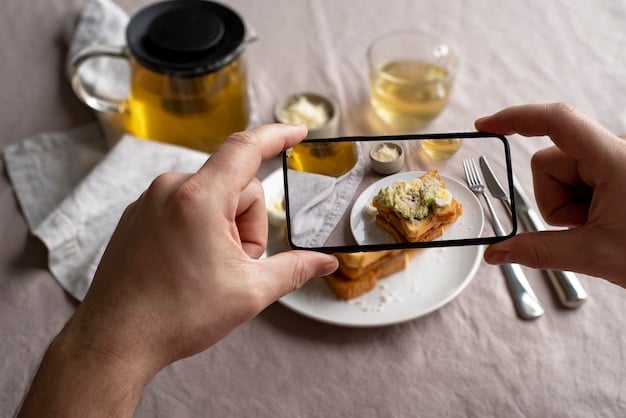Professional food photos on Instagram get thousands of likes in minutes. Home cooks often ask, “Why don’t my dishes get the same attention?” The answer is simple: it’s not about having expensive cameras or professional lighting. It’s about knowing the right plating process and food aesthetics techniques.
Food Photography Prevalence: 50% of Americans take pictures of their food.
The pressure is real.
But here’s what most people don’t know: the best food photographers don’t spend hours arranging their dishes. They follow specific, repeatable steps. These techniques transform ordinary meals into Instagram-worthy food items.
Social Media Sharing: 44% of people regularly post pictures of their meals on social media.
This guide breaks down professional food presentation into clear, actionable steps. You’ll learn how to:
Choose the perfect plate for any dish, whether it’s a tender cut of meat or fresh vegetables
Create height and depth that cameras love, giving your dishes a visual appeal that attracts attention
Use color psychology to make your food irresistible, ensuring the right mix of colors that draw the eye
Master natural lighting with household items, making your plates of food shine without needing fancy equipment
These aren’t complex tricks. They’re proven techniques used by top chefs and food photographers. With these skills, you’ll learn how to present food in a way that impresses guests and increases social media engagement.
By the end of this guide, you’ll know exactly how to create beautiful, shareable dishes that attract customers and make a big impact on your social media presence. With a little hard work, your meals will be as stunning in photos as they are delicious on the plate. To further enhance your skills, explore our in-depth guide on effective food presentation styles. These tried and true food-plating methods can significantly elevate your dishes and make them more visually appealing. Discover various effective plating techniques that can transform your culinary creations into mouthwatering art that is sure to impress your guests and followers.
Boost customer satisfaction with just a few clicks
Most-Loved Features:
- On-demand drivers
- Real-time GPS tracking
- Delivery confirmation photos
- Over 50% of customers report a smoother delivery experience
Step 1: Mastering Plating Techniques for Instagram
Plates make food look better.
Balance can make your dish pop.
Height and layers bring life to plates.
1. Choose the Right Plate to Plate Food
The plate is the stage for your dish. It should match the size and shape of what you’re serving. If you’re plating a large steak, a big rectangular or oval plate works well. For a delicate dessert, a smaller, round plate may fit better. Steer clear from busy patterns; they take attention away from the food. Stick with neutral colors like white or cream. These colors let the vibrant colors of your dish stand out. Michael Welch, a notable chef, mentions avoiding blue plates. Why? Blue isn’t a natural food color. It might not make food look appetizing.
Engagement Boost: People are 30% more likely to engage with food photos compared to non-food photos.
2. Arrange with Balance and Symmetry
Balance is crucial for a visually appealing dish. A good way to get this right is by using the clock method for seamless presentation. This arranges the elements in a way that’s easy for the eye to follow. Keep negative space—empty areas on the plate—in mind. It helps highlight the dish and makes it look elegant. As Chef Brian Poe advises, view plating as an art form. Watch what others do, learn the technique, but also find your style.
Precision and Cleanliness
The presentation must be polished and tidy. Organize each element neatly to avoid a cluttered look. Clean any spills or smudges on the plate’s rim before serving. This step ensures that the focus stays on the food, not any distractions.
Meal Focus: 72% of food pictures shared online showcase a main meal.
3. Add Height and Layers
Adding height and layers brings dimension to a dish. Stack components like proteins on top of starches or layer sauces under the main components. For precision, use tools like ring molds. They give structure and can shape ingredients neatly. Chef Daniel England suggests building from the bottom up. This method adds structure and creates visual interest.
4. Finish with Garnishes
Garnishing adds the final touch. Choose elements that enhance the dish. Edible flowers or fresh herbs can add a splash of color and texture without overwhelming. Make sure they complement the flavors. Michael Welch notes that overcrowding with unnecessary decorations detracts from the dish. Simplicity often works best, letting the core elements shine through. Jim Solomon also stresses the importance of balance and intention with garnishes.
Remember, how you plate can reflect a dish’s taste even before someone takes the first bite. Take these steps, and you’ll have dishes that not only taste great, but also look ready for Instagram.
Step 2: Creative Food Styling Tips for Eye-catching Presentation
Use colors that pop for appeal.
Blend textures to keep interest.
Light it right for perfect photos.
Use Color Contrasts
Strong color contrasts make dishes stand out. They catch the eye and hold attention.
Choose Bright Colors: Select bright ingredients. Red peppers, yellow corn, and vibrant greens work well.
Use Complementary Colors: Mix colors that are opposite each other on the color wheel. Think red and green, or blue and orange.
Consider Plate Color: Plates should complement the dish. White or neutral colors usually work best. Avoid patterns; they distract from food.
“The easiest way to add colour is to start working with more colourful ingredients. Items like carrots, potatoes, cauliflower, lettuces, beans, and more come in a variety of gorgeous colours. The difference a purple cauliflower puree makes on a plate is striking.” – Tanner Agar
Texture Variation is Key
Mixing textures keeps dishes exciting. Ensure each bite offers something different.
Incorporate Different Textures: Combine smooth purées, crunchy garnishes, and creamy sauces.
Make Components Identifiable: Each part of the dish should be layered. Use garnishes to separate similar textures.
Play with Foams: Add foams for a light texture. These can be made from juices or broths. This also adds a modern touch.
Layer Your Ingredients
Stack Ingredients: Layering adds depth. Place items from heaviest to lightest.
Add Height With Garnishes: Use height to create an appealing profile. Small herbs or greens can finish this off nicely.
Capture the Right Light for Photos
Good lighting makes a big difference. Photos need to be clear and bright.
Choose Natural Light: Natural light is soft and even. Position dishes near a window. Avoid direct sunlight to reduce harsh shadows.
Dodge Strong Shadows: Use a white reflector. This could be a piece of white paper. Place it opposite the light source to bounce light back.
Use a Lightbox for Dinner Service: If photographing in the evening, a lightbox gives even lighting. It’s simple to use: place the dish inside, and adjust according to need.
All these steps not only improve presentation but actually enhance perceived taste and value. Presentation invites diners in, and the way food looks often precedes how it’s experienced. Keep these tips in mind to elevate every dish you serve.
Step 3: Developing Visual Appeal in Culinary Art and Food Plating
Quality ingredients boost dish appeal.
Minimalist styling puts focus on main elements.
Precision ensures a clean, professional look.
Developing visual appeal in culinary art enhances the dining experience. It transforms a simple meal into a feast for the eyes, making it more enticing. Presentation not only communicates the quality of the dish but also the creativity of the chef.
1. Focus on Ingredient Quality
Fresh and Vibrant Produce
Quality ingredients are the backbone of any visually appealing dish. Fresh fruits and vegetables bring natural colors that capture attention. Even online, vibrant produce indicates a dish is fresh, nutritious, and carefully prepared. A dinner plate with bright bell peppers or deep green kale immediately conveys a sense of freshness and quality. Expert chefs emphasize this, viewing ingredient selection as crucial to the aesthetic and flavor profile of a meal. A dull carrot or saggy lettuce might suggest a lack of care, impacting the perceived taste and appeal.
High-Quality Proteins and Grains
Not only produce but proteins and grains should be top-notch. Well-marbled meat or perfectly cooked grains add texture and sophistication. A juicy steak’s marbling indicates tenderness, while quinoa’s sheen suggests cooking precision. Selecting supreme quality ingredients might require extra costs, but it assures reliability in achieving visual and taste excellence.
2. Emphasis on Minimalism
Less Clutter Equals Greater Focus
Less truly is more when it comes to food presentation. Minimalist styling draws attention to the main elements, preventing distraction from excessive garnishes. The elegance of minimalism lies in its simplicity, directing focus to the dish’s main components. A skillfully seared piece of fish on a simple bed of mashed potatoes can speak volumes without needing frills. Reducing visual clutter allows diners to appreciate the dish without feeling overwhelmed.
Main Ingredients as the Star
Minimalism complements high-quality ingredients, allowing them to shine. This approach makes the primary elements of the dish the star players. Instead of overloading a plate, spotlight the hero ingredient. Many food professionals prefer this method for its elegance and sophistication, leveraging simplicity to communicate creativity.
3. Precision and Neatness
Neat Arrangement of Components
Careful arrangement of items on a plate demonstrates professionalism. Even spacing and thoughtful placement ensure the dish remains inviting. A haphazard pile of ingredients might taste the same, but the allure created by neat organization is unmatched. A tidy presentation reassures the diner about the chef’s skills and the kitchen’s hygiene standards. Culinary experts often describe each plate as a canvas where balance and precision tell the dish’s story.
Clean Up the Plate
Once plated, any spills or smudges should be cleaned right away. Clean borders of the plates serve to frame your culinary art, ensuring nothing distracts from its center. Wiping the plate emphasizes attention to detail, showing customers that every step in preparation was taken with care. “A chef is an artist who creates edible masterpieces” encapsulates this sentiment, urging chefs to treat each plate as an artistic expression.
Visual appeal in culinary art is a craft that combines quality ingredients, minimalist styling, and attention to detail. As chefs refine each dish, they mirror artists, crafting pieces that excite both the eye and palate.
Advanced Tips for Modern Dish Presentation Ideas
Enhance cultural connection with each dish.
Elevate taste experience using novel ingredients.
Amplify Instagram aesthetics with strategic plating.
1. Integrate Cultural Touches
Integrating cultural elements in dish presentation can transform a meal beyond taste. This technique enhances authenticity and crafts a narrative for diners. Consider incorporating traditional designs, making dishes not only distinct but also visually rich. Aim for a cohesive look that connects the cuisine’s heritage with modern dining trends. Traditional utensils or ceramics sharpen this portrayal of cultural depth, creating a joyful dining experience that respects origins.
From a practical point of view, balancing cultural elements with modern plating techniques can pose challenges. Rigorous attention is needed to prevent cultural elements from overwhelming the overall presentation. Sources like “Japanese Culinary Arts: From Tradition to Modern Cuisine” offer insights into achieving this harmony. Students of this art often find inspiration in books and travel experiences that expose them to the diversity and richness of global culinary traditions.
2. Experiment with Uncommon Ingredients
Playing with unconventional ingredients can elevate dish visuals and flavors. Specialty herbs, like rare microgreens, lend fine detail. Unique additions such as edible flowers or gold flakes can turn a simple dish into a centerpiece. “Molecular Gastronomy: Exploring the Science of Flavor” often suggests using foams or gels as a gateway to innovative plating. Pick elements that naturally enhance the dish, rather than just as decorations.
From a scientific perspective, the use of these ingredients can influence a diner’s perception. The challenge lies in harmonizing flavors without overpowering the dish’s base notes. This requires a solid understanding of both the ingredient’s culinary role and the taste profiles of the cuisine being prepared.
3. Play with Geometric Shapes
Incorporating geometric shapes can modernize presentation. Uniformity in shape—achieved with tools like molds—offers a clean, professional look. Chefs employ geometry to forge visual intrigue, guiding the observer’s focus to key elements. This method, however, requires precision. Shapes can be built through stacking, cutting, or arranging ingredients meticulously.
Geometric styling causes the eye to journey through the plate, often drawing diners’ attention to the arrangement and structure. Books such as “Culinary Geometry: The Art of Food Design” explore how geometry influences visual appeal. Critics argue that this approach, while striking, risks reducing food presentation to a formulaic exercise. Striking a balance between geometric precision and organic spontaneity can create allure without appearing contrived.
Pizza Popularity: 41% of social media users are most likely to notice photos of pizza.
4. Utilize Modern Cooking Techniques
Embrace methods like sous-vide or cold-stone plating to enhance flavor and presentation. Sous-vide, for instance, can yield a perfect texture that complements visual appeal. Modern techniques often highlight the art of gastronomy, weaving aesthetic and sensory delight. While these require advanced equipment, they promise a dazzling display worthy of social media.
Critics of sous-vide argue that prolonged cooking might lessen certain textures, possibly detracting from the dish’s intent. It is essential to maintain varieties in texture, as highlighted in culinary critique works. The Modernist Cuisine movement advocates for this evolving approach, offering references such as “The Art and Science of Cooking with Sous-Vide” to dig deeper into the potential and challenges these techniques present.
5. Lighting as a Presentation Tool
Lighting plays a critical role in dish visibility and appeal, often underestimated. Soft lighting can highlight the natural beauty of ingredients, emphasizing textures and colors. Consider the setup: direct light sources might cast unwanted shadows, so use diffused light to enhance your plating.
Culinary experts, like acclaimed chef Joyce Tang, stress the key role of lighting, especially in photography. Advanced photography books like “Cook It, Shoot It: A Chef’s Guide to Food Photography” delve into how lighting can be used to transform a plated dish into a mouthwatering spectacle. Natural light remains a favorite, yet understanding artificial light setups paves the way for more control and creativity.
Troubleshooting Common Issues
Small changes can solve plating problems.
Better colors and spacing improve dish appeal.
Simple fixes save time and improve presentation.
Solutions for Plate Overflow
Tackling overflow can refine the dish’s presentation. It ensures the dish looks inviting and neatly arranged.
Reduce Portion Sizes for Better Flow
Assess the Dish: Start by evaluating the amount of each component on the plate. Aim for a balanced arrangement without overcrowding.
Measure Consistently: Use measuring cups or kitchen scales to portion ingredients evenly. This helps maintain consistency across servings and makes the dish look polished.
Focus on Key Elements: Highlight the main components of the dish. Reduce any side items that don’t add substantial value. This directs attention to the featured flavors and avoids clutter.
Observe Customer Preferences: Understand your audience’s consumption patterns. Offering portion options can cater to varying appetites and preferences.
Choose carefully which parts of your dish to spotlight. Balancing these aspects avoids the common trap of oversized serving.
Select a Bigger Plate for More Room
Choose a Suitable Plate: If reducing portions isn’t feasible, select a larger plate to provide more space. This allows for better spacing and the use of negative space.
Check Plate Availability: Have multiple plate sizes on hand. This flexibility helps accommodate different dish types and ensures each presentation looks its best.
Balance Proportions: Place items mindfully, leaving space between components for better visual appeal.
These adjustments ensure your dish looks inviting, drawing the diner’s attention and enhancing their experience.
Fixing Unappetizing Colors
A vibrant dish catches the eye and heightens the desire to taste it. Address color issues by enhancing both the ingredients and environment.
Add Fresh, Colorful Garnishes
Select Bright Vegetables: Incorporate vegetables in contrasting colors for vibrancy. A sprinkle of diced red peppers or green herbs boosts appeal.
Use Edible Flowers: Edible flowers like nasturtiums or pansies can bring an unexpected pop of color to a plate. Ensure they’re fresh and safe for consumption.
Consider Freshness: Keep garnishes crisp and fresh. Wilted or dull garnishes detract from the overall look of the dish.
Change Garnishes Seasonally: Adjust garnishes based on seasonal ingredients to keep the presentation dynamic and relevant. This supports food sustainability by utilizing local produce.
According to celebrity chef Donatella Arpaia, “We eat with our eyes first. People taste with their eyes and want to be wowed with the presentation.” Applying colorful garnishes aligns with this philosophy.
Adjust Lighting for Improved Color Capture
Natural Light Usage: Use natural light whenever possible. It highlights true colors and enhances all elements of the dish.
Correct Harsh Shadows: Adjust by using reflectors or diffusers to balance the light and reduce harsh shadows. This can be done with inexpensive tools for great results.
Set LED Lights for Evening Services: If natural light isn’t available, choose LED lights that mimic daylight quality. They provide even lighting and consistent results.
Experiment and Adjust: Review how dishes appear under different lighting setups. Make minor adjustments where necessary for the best outcome.
Lighting impacts how colors pop on the plate. Simple tweaks can upgrade presentation, making dishes look fresh and desirable.
Further Resources and Reading
Books like “The Art of Plating” dive into advanced principles.
Online courses sharpen real-world presentation skills.
Enhancing food presentation boosts culinary careers.
Books and Online Courses
Professional growth in food presentation can be achieved through a range of books and courses. Titles like “The Art of Plating” stand out for their detailed exploration of plating techniques and the psychological impact of visual presentation on dining experiences. This book goes beyond the basics, covering how color schemes and textures contribute to the perception of taste. Another essential read is “The Chef’s Table,” which provides an insider perspective on high-end culinary artistry.
Online courses also offer practical, skill-building experiences. Platforms like Coursera and MasterClass host experts who guide learners through hands-on exercises. These courses often include step-by-step tutorials on plating for various cuisines, from traditional French styles to modern fusion techniques. This method of learning equips professionals with skills directly applicable in kitchens.
Importance of Food Presentation Skills
Food presentation plays a critical role in the overall dining experience. First impressions are often the most memorable, and well-presented dishes engage customers right from the start. As Gordon Ramsay once said, “The visual presentation of food matters as much as its flavor.” Beyond aesthetics, skillful presentation enhances customer satisfaction and repeat visits.
Professionally, mastering presentation skills is crucial. A strong visual appeal can set chefs apart in competitive culinary environments. With social media amplifying how food is shared and perceived, chefs with a flair for presentation enjoy increased visibility and recognition. Moreover, the rise of platforms like Instagram highlights the business aspect of presentation, urging a thoughtful approach to every dish.
Instagram Food Focus: 43% of Instagram users cite food and drink as top interests.
Sustainability in Food Presentation
Sustainability in food presentation is becoming increasingly significant. Modern diners are more conscious of how their food is presented and the environmental impact of these choices.
Chefs are adapting by using sustainable materials and reducing waste. This trend emphasizes the role of presentation in promoting sustainable dining. Many culinary professionals now source local ingredients to diminish their carbon footprint, creating dishes that are environmentally responsible without sacrificing aesthetics. This shift is not just a trend but a reflection of evolving customer values, which increasingly influence business practices.
Beyond Consumption: 40% of people upload images of food they don’t intend to consume.
Advanced Topics and Emerging Trends
Exploring advanced topics and industry trends can further deepen your understanding of food presentation. For instance, the integration of technology is reshaping how chefs approach plating. Emerging tools may include anything from advanced lighting setups to digital garnishing techniques that offer unprecedented precision.
Upcoming culinary trends further expand presentation possibilities, with Korean, Vietnamese, and Filipino cuisines gaining traction. These cuisines offer innovative ways to incorporate bold colors and textures into presentation, inviting exploration into fusion and cultural expression. Understanding these trends can broaden a chef’s toolkit beyond traditional methods and into more dynamic, globally influenced aesthetics.
Conclusion
Food presentation has evolved beyond a chef’s craft into a crucial element for social media engagement. Fundamental principles remain key: selecting quality plates, balancing your composition, and leveraging natural light. These methods ensure your photos not only look professional but also entice the taste buds and appeal to your guests’ expectations.
Consider these plating techniques as essential tools in your culinary arsenal. Just as you choose specific utensils for cooking, diverse food presentation tips cater to different dishes. Begin by refining one aspect, like plate selection or lighting, then gradually integrate additional techniques like using edible garnishes or plating tools into your routine.
The most captivating food photos arise from dedication and attention to detail. Clean white plates, fresh ingredients, and thoughtful arrangements—whether it’s the presentation of fish, meat, or vegetables—distinguish exceptional photos from the rest. Remember, simplicity often yields a big impact, especially when served in smaller portions or adorned with edible flowers. Creative use of sauces and textures can elevate the dining experience, leaving a lasting impression on your guests.
Persist in honing these plating skills until they become natural parts of your cooking process. With each dish you plate and photograph, whether it’s a dessert or soup, your proficiency will flourish. Food plating and presentation go beyond just social media; it’s about creating a dining experience that attracts customers and shows respect for your ingredients.
Start with your next meal. Experiment with a technique from this guide, such as using decorating brushes or squeeze bottles for an artistic touch, and watch your dishes turn into Instagram-worthy creations. Your guests will appreciate the effort, and your restaurant marketing will shine with beautiful plates of food that are as delightful to look at as they are to eat.














